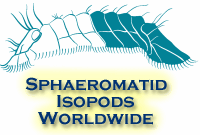| Abstract |
Decreasing deep-sea floor temperatures during the mid Cainozoic, and a presumed widespread disoxia in the deep sea prior to this era has lead many authors to suggest that the deep-sea fauna has accumulated during the last 30-40 mybp only. This hypothesis argues for extinction and replacement of earlier faunas. Some taxa, such as the Ostracoda, show extensive taxonomic replacement during the Miocene that is correlated with declining sea floor temperatures. A recent evaluation of the deep Atlantic distribution of major isopod clades, however, demonstrated that two different historical patterns are present. One pattern ("Flabellifera") conforms to a relatively recent Cainozoic and ongoing colonization of the deep sea, with relative impoverishment of species with depth. The other pattern (Asellota) is one that is rich in deep-sea species, and has a high level of endemic morphological diversity, suggesting a long period of evolution in isolation. Glaciation during the late Palaeozoic and an early phylogenetic origination of the Asellota support the hypothesis that these isopods colonized the deep sea prior to the disoxia events during the Mesozoic and the early Cainozoic. The Mesozoic deep sea is unlikely to have become completely anoxic globally owing to vertical halothermal circulation at low latitudes, allowing the possibility of oxygenated refuges in deep water. Elements of the Palaeozoic fauna, therefore, may have persisted through the Mesozoic without representation in marine shallow waters. Within the isopods, these Palaeozoic relicts have taken two adaptive directions. In freshwater, the Phreatoicidea show morphological stasis, with modern taxa resembling fossils from Carboniferous and Triassic eras. The Asellota, on the other hand, have evolved into a many different morphological types and a huge number of species globally. |

















